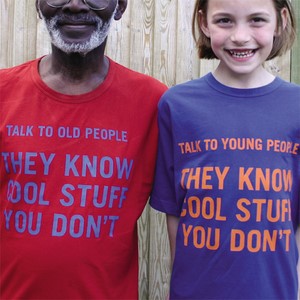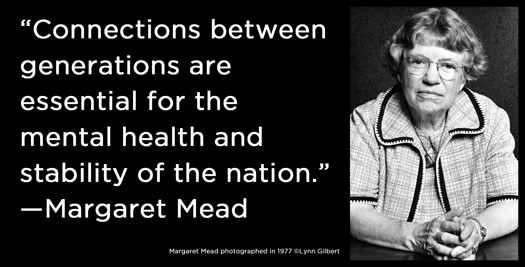Bridging Generations Enriches Communities
 I grew up in a small Midwest town in the 60s and enjoyed daily interaction with older adults—relatives, neighbors, church members, shopkeepers. My paternal grandparents lived in the same town, and I got to see them at least weekly. All generations were part of the beautiful tapestry that was my childhood and they each had a hand in raising me.
I grew up in a small Midwest town in the 60s and enjoyed daily interaction with older adults—relatives, neighbors, church members, shopkeepers. My paternal grandparents lived in the same town, and I got to see them at least weekly. All generations were part of the beautiful tapestry that was my childhood and they each had a hand in raising me.
Today, by contrast, generations feel siloed, missing out on precious opportunities for meaningful engagement and relationships. Society sometimes feels segregated by age.
We need to bridge the generations to enrich our communities. I am guided and encouraged by the wise words of one of my childhood heroes, Margaret Mead, who said, “Connections between generations are essential for the mental health and stability of a nation.”

How did this age segregation happen?
In Prime Time: How Baby Boomers Will Revolutionize Retirement and Transform America, Marc Freedman chronicles the advent of retirement living in the U.S. Here we begin to see the advent of age-restricted housing and communities, which has contributed in part to age segregation. When people are grouped by age instead of engaging with one another, something important is lost.
About the time Freeman wrote Prime Time, Robert Putman published Bowling Alone: The Collapse and Revival of American Community. Putnam looks at social capital and how it has eroded over time, contributing to a decline in community networks and meaningful connections. There are a number of contributors—jobs that move us away from family and friends, living in suburbs, long commute times, work demands, changes in family structure, electronic entertainment, structured “free time”—all allowing less time for civic engagement, involvement, family, friends, and neighbors.
There’s a revolution happening
In response to this need for generations to reunite, especially older and younger, I discovered a quiet, growing, intentional revolution taking place in the greater Puget Sound area. To learn more about this encouraging trend, I spoke with local intergenerational programs expert Dr. Jen Kulik, founder and CEO of Silver Kite Community Arts, a Seattle-based organization that offers curriculum-based and after-school intergenerational programs bridging older adults and young people.
Jen never ceases to be amazed every time Silver Kite facilitates an intergenerational program or event. Something special, something life-changing for participants, happens at each gathering. She is motivated, as well, by her own experiences as a kid and the special relationship she enjoyed with her grandfather.
What are the benefits of bridging the old and young?
There is growing research to support the benefits and value of the old and young spending regular time together.
Intergenerational programs help:
- Reduce negative stereotypes, prejudice, and discrimination associated with older adults and aging, as well as those associated with younger people.
- Improve students’ academic, behavioral, social-emotional, and motivational outcomes.
- Improve older adults’ social-emotional and motivational outcomes.
- Open new pathways for improving young people’s empathy toward older adults.
- Address the social isolation that certain age groups experience (to read more about social isolation and loneliness, click here).
- Improve physical well-being of older adults and kids.
- Provide a renewed sense of purpose in older adults.
- Improve the welfare of families and the community—remember, Margaret Mead told us this years ago!
Jen wrote her dissertation on intergenerational programs. She shared the story of a theater arts program she’d developed and launched 20 years ago, pairing homeless students with older adults from a retirement community in Phoenix. What the kids believed about themselves when they came into the program contrasted with what they learned and believed about themselves at the end of the program—it was positive, transformative, and encouraging. And the adults who participated found the experience equally energizing and affirming.
Today, Jen sees the need as even more essential. Recently, Silver Kite facilitators brought residents from a Life Plan Community in Redmond and an assisted living community in Issaquah together with groups of 8th graders from local schools through their Writing Life Stories program.
Through the program, students learn a variety of communication skills—everything from how to shake hands and introduce themselves to how to interview. Working in groups of three students with one adult, the students participate in writing assignments based on the interviews and create personalized memory boxes in honor of the person they interviewed. The boxes are presented to the interviewee at a ceremony at the end of the project.
Magic happens along the way. Many students don’t have regular interface with older adults, and the Writing Life Stories project gave them invaluable time to engage someone they might not otherwise have an opportunity to meet. The reverse is true as well. Many older adults have limited interactions with children and young adults outside their residential environment, and this focused time together is enriching. They come away from the experience recognizing they have a lot in common, despite their differences in age.
What other intergenerational connections are happening locally?
In addition to the variety of programs that Silver Kite offers throughout King and south Snohomish Counties, there are several other organizations offering meaningful engagement opportunities.
This by no means represents a complete list. Many programs at schools, faith communities, and various civic organizations offer opportunities for young and old to engage. My goal here is to provide a snapshot and encourage you to find ways to connect with younger people.
A few examples in long-term care settings:
- Perhaps one of the best-known local examples of regular intergenerational engagement is happening at the Intergenerational Learning Center (ILC) at Providence Mount St. Vincent—affectionately known as “The Mount” —an innovative living care community for older adults in West Seattle. Each day, planned and spontaneous activities and programs take place throughout the building and campus, where the children and residents regularly interact. To take a peek at what this looks like, enjoy this 2017 story from NBC News entitled Seattle Daycare and Nursing Home Intersect in Beautiful, Chaotic Harmony.
- At Bayview in Queen Anne, there’s a similar day program called the Intergenerational Children’s Center. Children engage with residents every day through programs and activities.
- In Des Moines, Wesley Communities has recently added two programs. A Montessori preschool run by the Highline School District is located at the Wesley Homes Health Center, where residents regularly volunteer and engage with students. Wesley has also partnered with Highline College to offer the first students-in-residence program in the Pacific Northwest. Based on similar models in The Netherlands and on the East Coast, five Highline College students-in-residence, in exchange for a reduced-rate studio apartment on the main Wesley Homes campus, volunteer 10 hours a week with residents.
- Northaven Senior Living and North Seattle College have been exploring how to support four students currently experiencing homelessness. The plan is to follow a model similar to that at Humanitas in Deventer, Netherlands, providing housing for the students in exchange for volunteer engagement within the Northaven community.
Other organizations that bring together generations include:
- Generation to Generation (Gen2Gen): To read an AgeWise article written by Andy Odom, who directs outreach for Gen2Gen Seattle, click here. Gen2Gen Seattle is part of a larger national network focused on recruitment and training of adults age 50+ to “improve the lives of young people in vulnerable situations, reinforcing the interdependence between older and younger generations.”
- Age Friendly Seattle: Framed by the World Health Organization’s 8 Domains of Livability, age-friendly communities consider all ages intentionally. The Social Participation and Respect and Social Inclusion domains have strong intergenerational foci.
- Big Brothers Big Sisters Puget Sound: As the nation’s largest donor and volunteer supported mentoring network, BBBS’s mission is “to provide children facing adversity with strong and enduring, professionally supported 1-to-1 relationships that change their lives for the better.”
What’s happening elsewhere?
Across the U.S., there are many intergenerational initiatives and programs:
- Generations United: This membership organization’s vision is “A world that values and engages all generations.” They offer excellent resources, ideas, inspiration, and collaboration to improve lives, policy, and programs.
- TimeOut@UCLA: An innovative intergenerational program that gives older adults living with dementia an opportunity to mentor college students, Time Out provides caregiver respite.
- The Alive Inside Coalition: “Dedicated to healing loneliness and disconnection in all our lives, especially in the lives of the very young and the very old living with dementia.” The Coalition uses music as the medium through which the magic happens.
- Live Well San Diego: This County of San Diego Aging & Independence Services intergenerational program grew out of their age-friendly initiative. Programs include community gardening, annual Intergenerational Games, math, writing, and reading clubs.
- Generations of Hope: A model of Intentional Neighboring for community living, where everyone, including the most vulnerable, gives and receives care and support. One such example is Bridge Meadows in Portland, Oregon.
- The Buddy Program™: Northwestern University’s Feinberg School of Medicine offers medical students a unique opportunity to build relationships with persons who have Alzheimer’s disease or other related illnesses outside of a clinical setting.
- The Intergenerational Schools: Located in Cleveland, Ohio, these schools create, connect and guide a multigenerational community to become lifelong learners and engaged citizens.
Are you inspired to make meaningful, lasting connections with a younger generation? Your wisdom, your presence, your talents are needed! What will you do? Where will you go?
Contributor Keri Pollock directs marketing and communications for Aging Wisdom, an Aging Life Care™ practice (geriatric care management) serving King and south Snohomish Counties. Pollock serves on the Age Friendly Seattle Task Force, the Creative Aging Programs Advisory Committee at the Frye Art Museum, and on the Alzheimer’s Association Discovery Conference planning committee.
![AgeWise King County [logo]](https://www.agewisekingcounty.org/wp-content/themes/agewisekingcounty/images/logo.png)